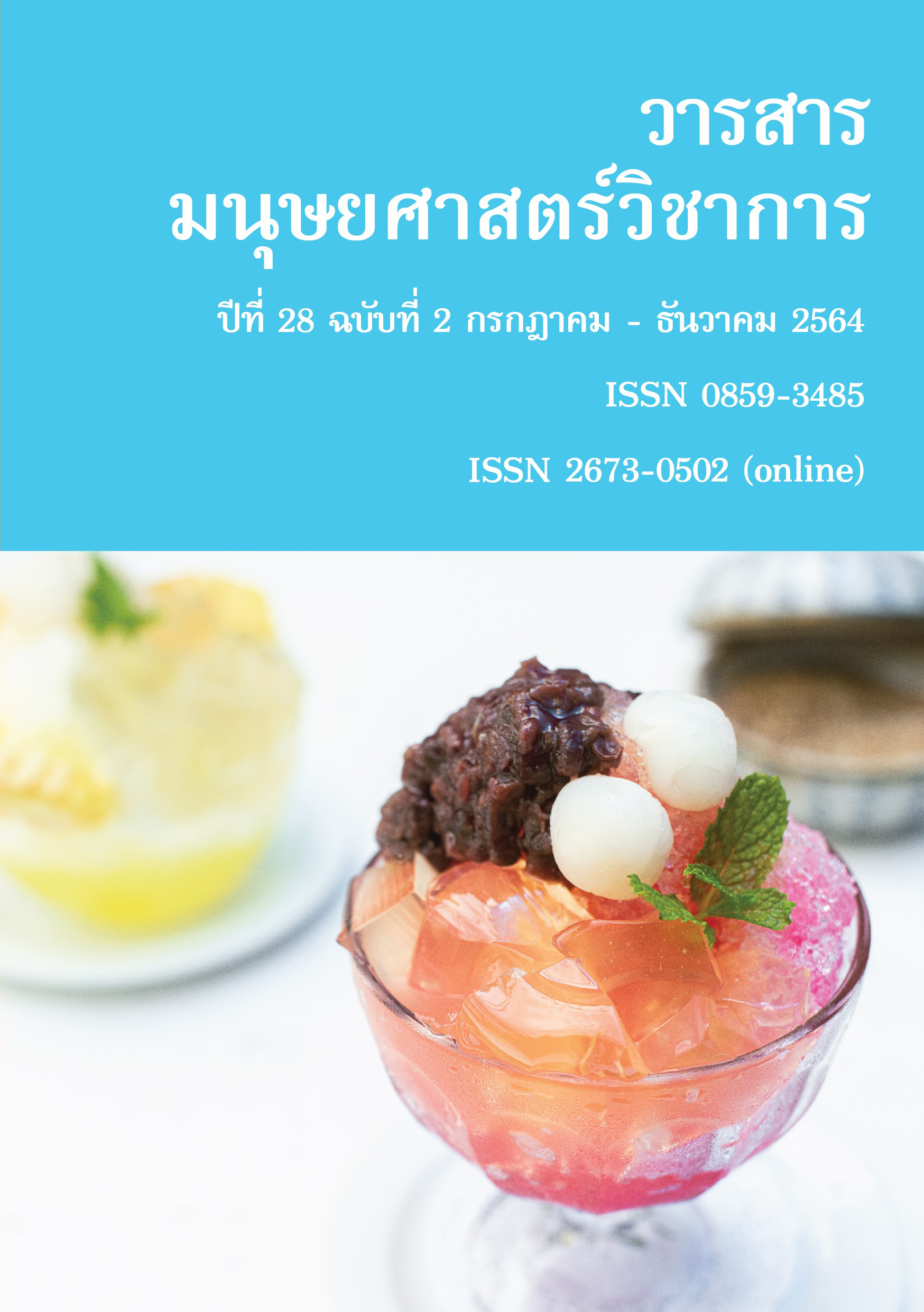The Meanings of /mɛ̂ː/ ‘Mother’ in Southern Thai Compounds
Main Article Content
Abstract
This paper aims to examine the different meanings of /mɛ̂ː/ ‘mother’ in Southern Thai compounds and investigate the relationship between those meanings. The data was compiled from 4 Dictionaries and interviews with 6 informants who are Southern Thai native speakers. The results show that in 180 Southern Thai compounds the word /mɛ̂ː/ 'mother' has 23 meanings which can be categorized close meaning together into 12 groups. When investigating the relationship between meanings, there is one basic meaning of ‘a woman who has given birth to a child’ and 22 extended meanings which can be classified into 2 types, (1) meanings that are extensions of the basic meaning and (2) meanings that are extensions of the extended meanings that more close to the basic meaning. Compared to the meaning of /mɛ̂ː/ in the base word, the meaning of /mɛ̂ː/ ‘mother’ in compounds are more numerous and varied, with the meaning in compounds extending or highlighting the connotation of the base word through cognitive progress that occurs in compounds.
Article Details
References
กาจบัณฑิต วงศ์ศรี. (2547). เครือข่ายความหมายของคำว่า 'ออก' ในภาษาไทย: การศึกษาแนวอรรถศาสตร์ปริชาน (วิทยานิพนธ์ปริญญามหาบัณฑิต). ภาควิชาภาษาศาสตร์ จุฬาลงกรณ์มหาวิทยาลัย.
ชลธิชา บำรุงรักษ์. (2547). การจัดทำพจนานุกรมภาษาไทยถิ่น 4 ภาค (ระยะที่ 5) (รายงานการวิจัย). กรุงเทพฯ: มหาวิทยาลัยธรรมศาสตร์.
ชัชวดี ศรลัมพ์. (2538). การศึกษามโนทัศน์ของคำว่า เข้า (วิทยานิพนธ์ปริญญาดุษฎีบัณฑิต). ภาควิชาภาษาศาสตร์ บัณฑิตวิทยาลัย จุฬาลงกรณ์มหาวิทยาลัย.
มหาวิทยาลัยราชภัฏนครศรีธรรมราช. (2551). พจนานุกรมภาษาถิ่นใต้ พุทธศักราช 2550 ฉบับเฉลิมพระเกียรติพระบาทสมเด็จพระเจ้าอยู่หัว ในวโรกาสเจริญพระชนมพรรษา 80 พรรษา. นครศรีธรรมราช : มหาวิทยาลัยราชภัฏนครศรีธรรมราช มูลนิธิร่วมพัฒนาภาคใต้ และสถาบันทักษิณคดีศึกษา
ราชบัณฑิตยสถาน. (2556). พจนานุกรมฉบับราชบัณฑิตยสถาน พ.ศ. 2554 : เฉลิมพระเกียรติพระบาทสมเด็จพระเจ้าอยู่หัวเนื่องในโอกาสพระราชพิธีมหามงคลเฉลิมพระชนมพรรษา 7 รอบ 5 ธันวาคม 2554.
รุ่งทิพย์ รัตนภานุศร. (2549). การขยายความหมายของคำกริยาแสดงการรับรู้ด้วยตาในภาษาไทย (วิทยานิพนธ์ปริญญาดุษฎีบัณฑิต). ภาควิชาภาษาศาสตร์ จุฬาลงกรณ์มหาวิทยาลัย.
วิภัสรินทร์ ประพันธสิริ. (2535). คำเรียกญาติในภาษาคำเมือง: การวิเคราะห์ทางอรรถศาสตร์ชาติพันธุ์ (วิทยานิพนธ์ปริญญามหาบัณฑิต). ภาควิชาภาษาศาสตร์ บัณฑิตวิทยาลัย จุฬาลงกรณ์มหาวิทยาลัย.
ศราวุธ หล่อดี. (2556). การเปลี่ยนแปลงความหมายของคำประสมที่มีคำว่า หัว ในภาษาไทลื้อ. วารสารมนุษยศาสตร์และสังคมศาสตร์ มหาวิทยาลัยพะเยา 1(2): 47-60.
ศุภชัย ต๊ะวิชัย. (2556). การขยายความหมายของคำว่า ‘หลัง’ ในภาษาไทย. ในรายงานสืบเนื่องจากการประชุมวิชาการมหาวิทยาลัยมหาสารคาม ครั้งที่ 9 : การวิจัยสู่ประชาคมอาเซียน ครั้งที่ 2, มหาวิทยาลัยมหาสารคาม, 12-13 ก.ย. 2556.
สถาบันทักษิณคดีศึกษา มหาวิทยาลัยศรีนครินทรวิโรฒ. (2530). พจนานุกรมภาษาถิ่นใต้ พุทธศักราช 2525. กรุงเทพฯ : อมรินทร์ พริ้นติ้ง กรุ๊ฟ.
อมรา ประสิทธิ์รัฐสินธุ์. (2533). ลักษณะสำคัญบางประการในวัฒนธรรมไทยที่แสดงโดยคำเรียกญาติ. ภาษาและวรรณคดีไทย 7(1): 56-68.
อลิษา อินจันทร์. (2557). คำประสมแบบเท่าเทียมในภาษาไทย (วิทยานิพนธ์ปริญญาดุษฎีบัณฑิต). ภาควิชาภาษาศาสตร์ จุฬาลงกรณ์มหาวิทยาลัย
อัญชลี สิงห์น้อย.(2551). คำนาม คำบ่งกลุ่มนาม และคำลักษณะนาม: หมวดหมู่ที่แตกต่าง ทับซ้อน และไล่เหลื่อม. วารสารภาษาและภาษาศาสตร์ 26(2): 21-38.
Bascom, B. and Casad, E. H. (2000). ‘Mother’ in Northern Tepehuan. In E.H. Casad, and T. L. Willett (Eds.), Uto-Aztecan, Temporal, and Geographic Perspective: Paper in Memory of Wick R. Miller by the Friend of Uto-Aztecan (pp.35-42). Mexico: Universitdad de Sonora
Croft, W. and Cruse, D. A. (2004). Cognitive Linguistics. New York: Cambridge University Press.
Kovecses, Z. (2002). Metaphor: A Practical Introduction. New York: Oxford University Press.
Lakoff, G. (1987). Woman, fire and dangerous things: What categories reveal about the mind. Chicago: University of Chicago Press.
Ungerer, F and Schmid, H. (1996). An introduction to Cognitive Linguistics. New York: Longman.


